Your Cart is Empty
by Christopher Pierce • 6 min read
Today, I'm incredibly excited to share with you a fresh chapter in our coffee journey.
I’ve just returned from a visit to Costa Rica where I had the chance to visit one of our coffee-producing communities at Aquiares Estate in Turrialba.
Our long-time fans will be familiar with the name Aquiares Estate; Summer of 2023 will mark the third consecutive year that we’ve carried this farm’s coffees on our menu. We’ve worked closely with Ally Coffee Importers to bring Aquiares’ coffees like the luxuriant Centroamericano Anaerobic Natural, and the fan-favorite, Esperanza Red Honey to you each year.
In June of this year, I had the tremendous opportunity to travel to Aquiares, and spend time with the farm manager, Diego Robelo. This wasn't just a trip to source great coffee; it was a chance for me to better understand the culture, hard work, and traditions that go into every cup we roast at Loom Coffee Co.
As I share this journey with you, I hope it adds a little something extra to each sip you take of our new offerings from Costa Rica.
Driving through the hills toward Turrialba, I couldn’t help but be captivated by the landscapes before me.
Mountains loomed in the distance, their peaks hidden behind a veil of wispy clouds. A patchwork of pastureland, dense forests, and verdant clusters of coffee trees stretched out as far as the eye could see. The sight was a testament to Costa Rica's moniker as the "rich coast.” The significance of the journey I was embarking on started to sink in - I was about to delve deep into the heart of coffee country, into the lives of those who work with dedication to produce our beloved brew.
The town of Aquiares, nestled in the embrace of these epic landscapes, was a delightful revelation. It was a tapestry of bustling streets, pastel-hued houses, and friendly locals, all imbued with an undercurrent of excitement and purpose. This was a community united by coffee, and it felt incredibly special to be welcomed into it.
The estate is not just home to coffee; it's home to a vibrant community as well. Over 1,800 people live here, their lives intricately woven into the rhythm of the coffee seasons. Their warm smiles, and the enthusiasm with which they speak of their work, highlight the sense of pride and belonging that is an integral part of the Aquiares culture. I was struck by the genuine respect and camaraderie between the workers and the farm management — a testament to the estate's commitment to its people.
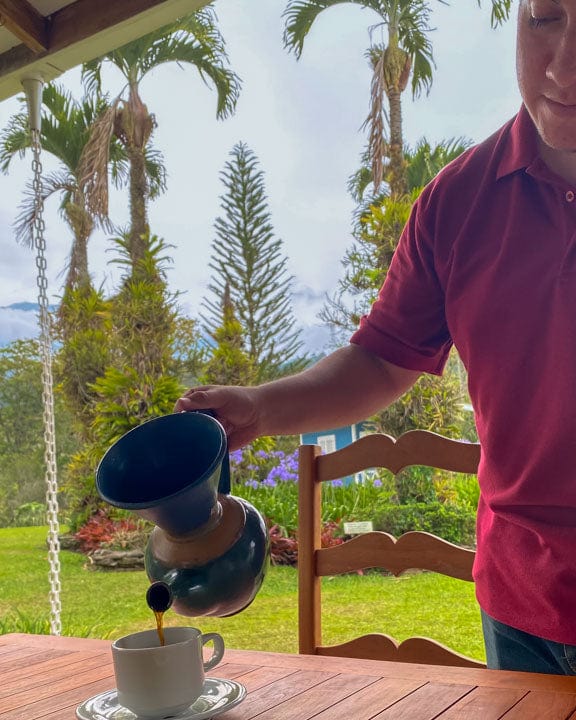
Aquiares resident, Jorge Núñez Jara pours coffee from the Vandola at Hacienda Esperanza.
I was greeted warmly by Jorge and Katheryn, the hospitality staff at Hacienda Esperanza. They immediately offered me coffee, freshly brewed using a ceramic pour-over device called a Vandola, which is the preferred home brewing method throughout Costa Rica.
After humoring my fascination with their pour-over method, we sat on the patio. We enjoyed the coffee and some banana bread - Jorge is an amazing baker - while looking out over the coffee fields, the mill, and the small Catholic church at the center of Aquiares.
Later on, Wilman, head of Aquiares’ agritourism program, gave me an in-depth look at the many processes which take place on the farm. He explained the calculated pruning process used to keep their coffee trees in optimal health and detailed their meticulous integrated pest-management strategies. Coming from a background in horticulture and agriculture myself, he was speaking my language.
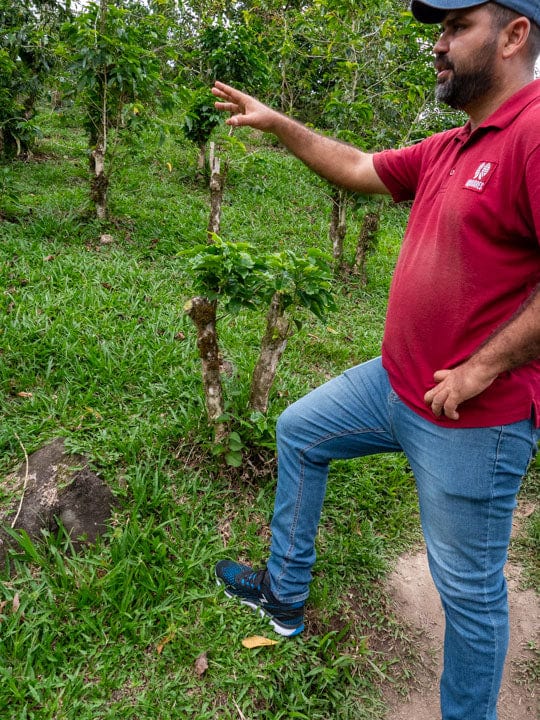
Wilman elaborated on several new projects at Aquiares, including cacao production and an initiative spearheaded by the women of Aquiares to begin producing essential oils.
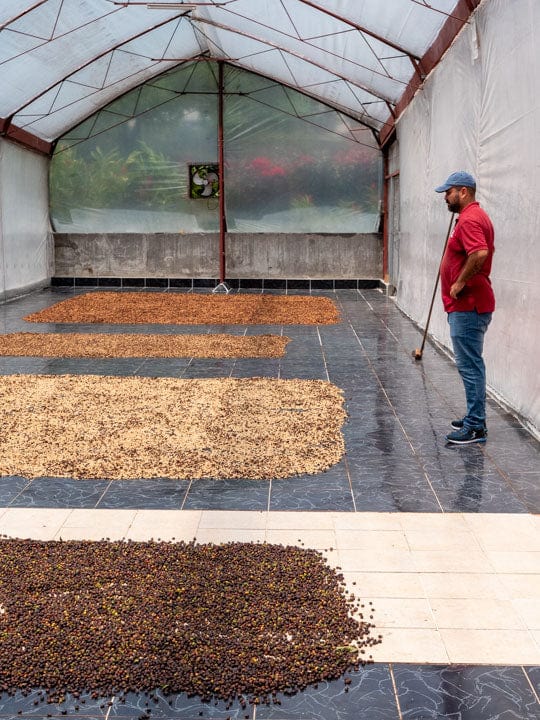
Specialty microlots at Aquiares Estate are carefully monitored while drying in the greenhouses.
At the heart of Aquiares’ innovation is Diego Robelo, a third-generation coffee producer and the farm manager at Aquiares. From the moment I met Diego, his passion for coffee and his commitment to sustainable and equitable practices were evident. His eyes light up when he talks about the coffee varieties they grow, the innovative farming techniques they use, and the care they put into every step of the coffee process.
Diego is the son of Alfonso Robelo, the man who brought about a renaissance at the Aquiares farm when he came into ownership in the late 1980s. A political refugee from Nicaragua, Alfonso initiated a campaign throughout the 1990s to improve home ownership within the Aquaires community, as well as to address issues such as equitable labor practices and education for farm workers at Aquiares. As a result, the farm benefits from a well-educated community and a highly skilled workforce. This interdependent, mutually beneficial way of life is crucial to the character of Aquiares — a progressive and innovative coffee estate that leads the industry by example.
Diego invited me to participate in a cupping session at the Aquiares quality-control lab, along with a few of my traveling companions who had arrived from California, and Michaela Tomchek - a traceability specialist from Mercanta Coffee Importers who was also visiting the farm. However, before heading to the QC lab, Diego had another errand in mind for our group. He needed to show us the Catarata de Aquiares — a 132-foot waterfall nestled in the jungle about one hour’s hike from the Hacienda.
The well-worn path through the forest winds its way through a vivid collage of lush coffee plants and towering trees, each step unveiling a new shade of green. The distant murmur of cascading water grows stronger as we descend into the river valley. Suddenly, the canopy opens up, revealing the waterfall — a moment of sheer awe and a potent reminder of nature's raw beauty, tucked away in this corner of the Aquiares Estate.
My friends and I clambered on the mossy rocks, slick and vibrant chartreuse. Diego wasted no time — he swam directly into the torrent beneath the falls, disappearing at moments and letting the power of the deluge take him under. He’d emerge from the frothing waters smiling from ear to ear.
The scene reminded me of playing in the creeks and forests of rural North Carolina as a kid, and how nourishing it can be to return to the unwavering embrace of nature throughout our lives.
Back at the Hacienda, we took a brief rest and then prepared to cup some coffees at the lab. Arriving at the mill, we found another opportunity for a detour: a new Probat sample roaster had just been delivered to the facility, and Diego couldn’t contain his excitement. Elated, he and Armando, the mill manager, eagerly uncrated the double-barrel roaster and marveled at the build of the machine — sleek blue steel and brass.
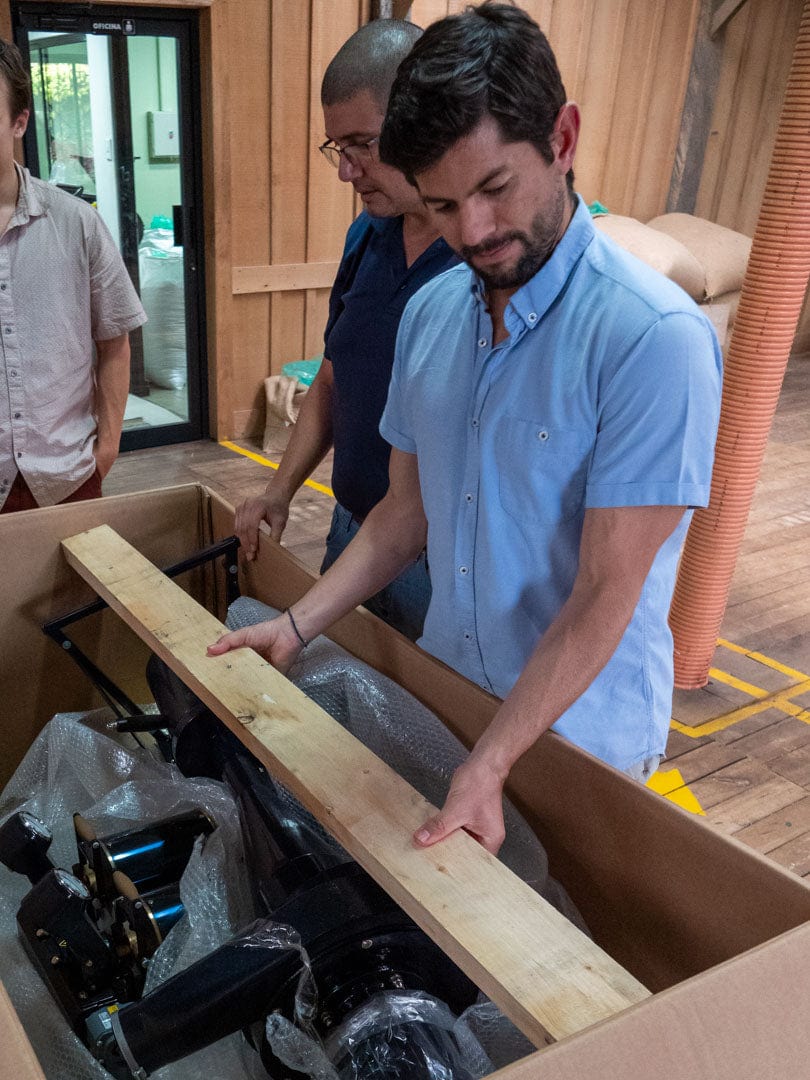
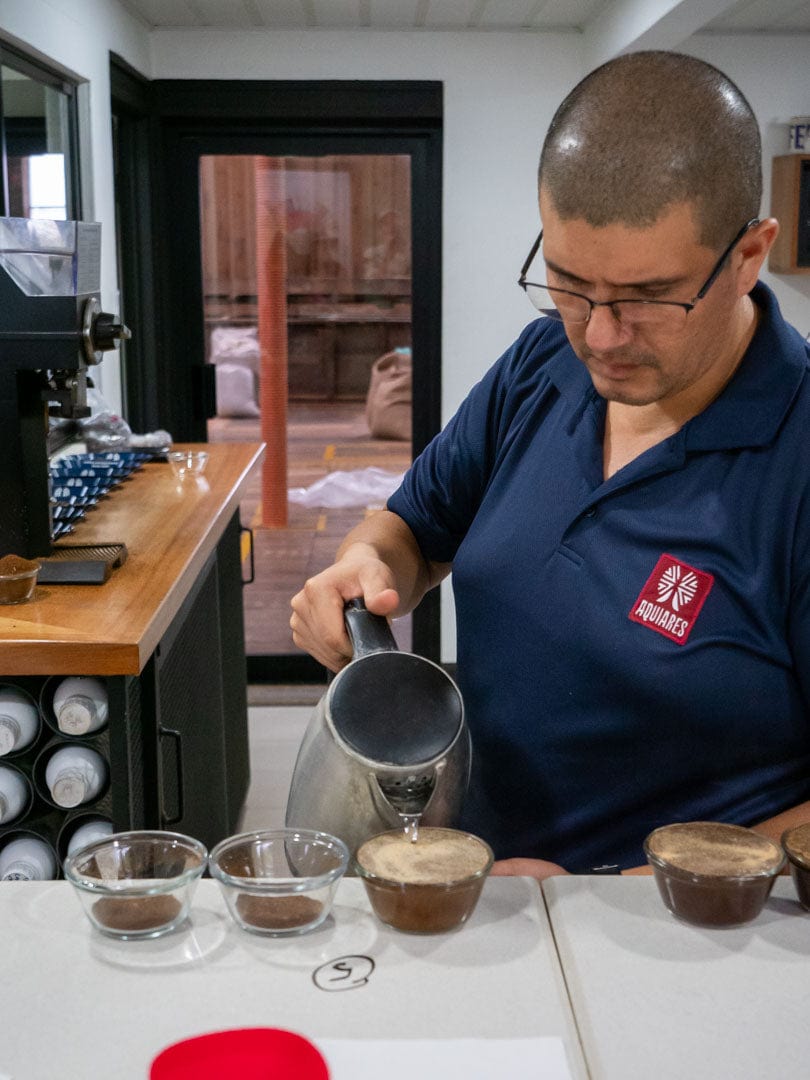
Michaela and I helped prepare the cupping table, weighing out doses of twelve unique Aquiares coffees. Armando made his way around the table and filled each cupping bowl with a prescribed amount of hot water, and set a timer for exactly four minutes. This would be a blind cupping, meaning that we wouldn’t know exactly which coffee varietal or processing method we were tasting in each cup.
There were several superb coffees on the cupping table, but two of the Aquiares offerings stole the show in terms of flavor, complexity, sweetness, and distinctive character. After comparing notes, Diego revealed that those two coffees were the same cultivar: Mariana. This variety is a newcomer to Aquiares — an F1 hybrid developed in Nicaragua, selected for its rust resistance, vigorous growth, and importantly, a stunning cup profile.
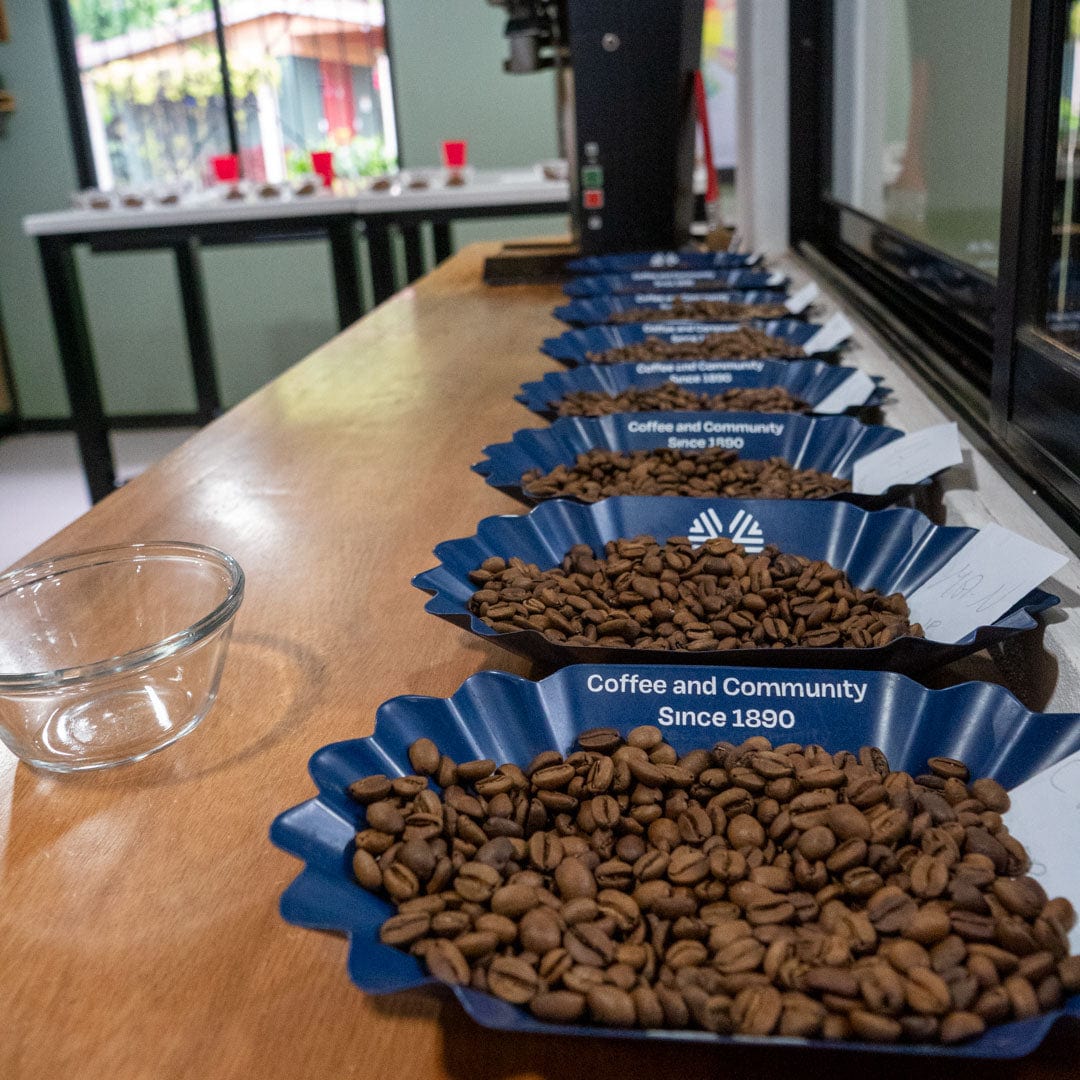
This year, the Mariana varietal from Aquiares placed into Round Two of the prestigious Cup of Excellence competition, representing a milestone for Aquiares and the Turrialba region. The honey-processed version was dark fruits in the cup — plum, cherry, guava, and molasses, while the naturally processed version carried a similar profile, along with some playful melon flavors, cantaloupe, papaya, and caramel sweetness. It’s a truly dynamic tasting experience, and there’s a lot of exciting interplay between the delicate acids and fruity sweetness. Juicy and clean mouthfeel, with a crisp and refreshing finish.
After the cupping, I spoke with Diego about bringing a limited run of the exquisite Mariana to our menu. I bought as much of the Mariana Natural as I could fit in my carry-on. We are incredibly proud to share this coffee with you — the latest chapter in the long history of innovation at Aquiares Estate.
My journey to Aquiares Estate reaffirmed my belief that our experience of coffee is about more than just the final product — the story behind the cup is equally important.
What’s more, we’re delighted to announce that the new crop of these coffees has arrived in the US by way of our friends at Ally Coffee. Ally continues to support awesome farmers like Diego Robelo by purchasing green coffee lots reliably, year after year — and they help us keep our menu stacked with unique, traceable, and sustainably produced coffees!
As we launch these unique offerings from Aquiares Estate, we invite you to be a part of this story. Allow these coffees to take you on a sensory expedition, connecting you to the mountains of Turrialba and the hands that nurtured these coffees.









